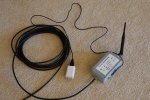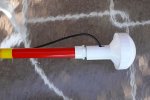Flying indoors can possibly be an iffy proposition. You loose GPS signal, your essentially in attitude mode. I recently snagged a Mini 2 to add to the collection and thought this would be quite nice indoors, some prop guards and rock on. So in my first attempt, it would never get more than 5-6 satellites and considering I live in the mountains at around 2200 meters, it puts the drone in High Altitude Mode warning. It is a bit wobbly. So I thought, "hey, I have this ultra cool GPS repeater to bring my aircraft systems online in the hanger without dragging it out into the snow!" I have to have complete lock on to make some adjustments and corrections to the aircraft system software.
So, it stopped snowing today and I motored out to the hanger, dug out the door (we got just over a meter of snow). Packed up the device and hauled it home. It has to have the repeater box and the transmitter about 10-15 meters apart with the head having a clear view of the sky. I set the beastie up and Lo! It works, 14 satellites, solid strong signal. The mini was ultra happy, stable. The cat is in big trouble now. Now if I can suss out how to make it hover less than ½ meter it would be even cooler.
The gizmo is not terribly expensive, around $100 on eBay.


So, it stopped snowing today and I motored out to the hanger, dug out the door (we got just over a meter of snow). Packed up the device and hauled it home. It has to have the repeater box and the transmitter about 10-15 meters apart with the head having a clear view of the sky. I set the beastie up and Lo! It works, 14 satellites, solid strong signal. The mini was ultra happy, stable. The cat is in big trouble now. Now if I can suss out how to make it hover less than ½ meter it would be even cooler.
The gizmo is not terribly expensive, around $100 on eBay.














